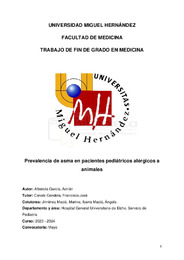Please use this identifier to cite or link to this item:
https://hdl.handle.net/11000/33710Prevalencia de asma en pacientes pediátricos alérgicos a animales

View/Open:
Prevalencia de asma en pacientes pediátricos alérgicos a animales-Adrián Alberola García.pdf
746,27 kB
Adobe PDF
Share:
| Title: Prevalencia de asma en pacientes pediátricos alérgicos a animales |
| Authors: Alberola García, Adrián |
| Tutor: Canals Candela, Francisco José Jiménez Maciá, Marina Ibarra Maciá, Ángela |
| Editor: Universidad Miguel Hernández |
| Department: Departamentos de la UMH::Farmacología, Pediatría y Química Orgánica |
| Issue Date: 2024-05-02 |
| URI: https://hdl.handle.net/11000/33710 |
| Abstract: Introducción: El asma es la enfermedad crónica más frecuente en la infancia y los aeroalérgenos pueden ser un factor desencadenante de esta y de rinitis alérgica (RA). La prevalencia de sensibilización a alérgenos de perro y gato es elevada actualmente y la evidencia no ha esclarecido su papel como factor de riesgo para el asma alérgica. Objetivo: Se comprueba la hipótesis de que la sensibilización frente a perro y/o gato se asocian con el desarrollo de asma. Material y métodos: Se realiza un estudio observacional transversal con información de pacientes pediátricos del HGUE con asma y/o RA sensibilizados frente a gato, perro, ácaros, salsola, olivo y/o alternaria. Se utilizan los datos de la prevalencia de asma en los distintos grupos de sensibilizados así como la intensidad de los síntomas de asma y RA y la respuesta del asma a la inmunoterapia con alérgenos (ITA). Resultados: Se han incluído 50 pacientes en los que no se han visto diferencias estadísticamente significativas para la prevalencia de asma entre alérgicos a animales y alérgicos a otros aeroalérgenos. No obstante, se observa una mayor prevalencia de sensibilización a animales entre los que conviven con perros y gatos (75%) que en los que no conviven con estos (17,4%) (p = 0.041). Se han visto más casos de asma grave en alérgicos a animales y de RA grave en los alérgicos a otros aeroalérgenos sin significación estadística. En el grupo de alérgicos a animales, hay más asma y RA graves en los polisensibilizados a gato y perro y en los alérgicos a gato en comparación a los que lo son a perro. También encontramos una mejor respuesta a ITA en los alérgicos a gato frente a los alérgicos a perro (p = 0.005). Conclusión: No se puede asegurar que la sensibilización a perro y/o gato se asocie al desarrollo de asma. La convivencia con perros y/o gatos es un factor de riesgo para la sensibilización frente a alérgenos de estos animales. Los pacientes con asma alérgicos a gato responden mejor a la ITA que los alérgicos a perro. Introduction: Asthma is the most common chronic disease in childhood and aeroallergens may be a trigger for asthma and allergic rhinitis (AR). The prevalence of sensitisation to dog and cat allergens is currently high and the evidence has not clarified its role as a risk factor for allergic asthma. Objective: We test the hypothesis that sensitisation to dog and/or cat allergens is associated with the development of asthma. Material and methods: A cross-sectional observational study was carried out with information from pediatric patients at the HGUE with asthma and/or AR sensitised to cat, dog, mite, salsola, olive tree and/or alternaria. We used data of the prevalence of asthma in the different sensitised groups as well as the intensity of asthma and AR symptoms and the asthma response to allergen immunotherapy (AIT). Results: We included 50 patients in whom no statistically significant differences were found for the prevalence of asthma between those allergic to animals and those allergic to other aeroallergens. However, a higher prevalence of sensitisation to animals was observed among those who lived with dogs and cats (75%) than among those who did not (17.4%) (p = 0.041). More cases of severe asthma were seen in those allergic to animals and of severe AR in those allergic to other aeroallergens without statistical significance. In the animal-allergic group, there is more asthma and severe AR in those polysensitised to cat and dog and in those allergic to cat compared to those allergic to dog. We also found a better response to AIT in cat-allergic versus dog-allergic people (p = 0.005). Conclusion: It is not certain that sensitisation to dogs and/or cats is associated with the development of asthma. Living with dogs and/or cats is a risk factor for sensitisation to those animal’s allergens. Cat-allergic asthma patients respond better to AIT than dog-allergic asthma patients. |
| Keywords/Subjects: Asma sensibilización perro gato rinitis alérgica ITA |
| Knowledge area: CDU: Ciencias aplicadas: Medicina |
| Type of document: info:eu-repo/semantics/bachelorThesis |
| Access rights: info:eu-repo/semantics/openAccess Attribution-NonCommercial-NoDerivatives 4.0 Internacional |
| Appears in Collections: TFG- Medicina |
.png)
